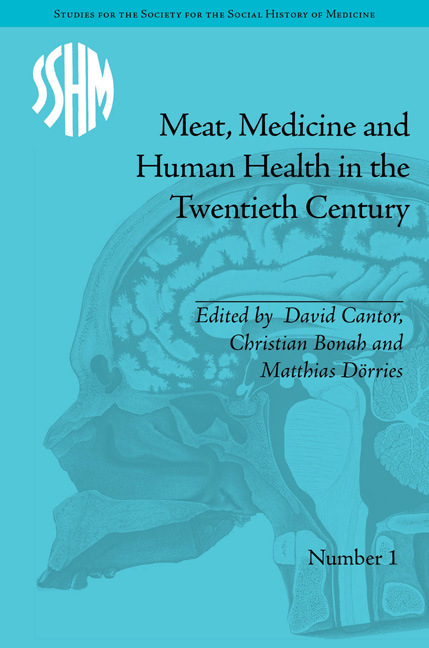Book contents
- Frontmatter
- CONTENTS
- Acknowledgements
- List of Contributors
- List of Figures and Tables
- Introduction
- Part 1 Meat and Therapeutics
- Part II Meat, Politics and Culture
- 4 What's Meatpacking got to do with Worker and Community Health?
- 5 Is Refrigerated Meat Healthy? Mexico Encounters the Chicago Meatpacking ‘Jungle’, c. 1910
- 6 Confused Messages: Meat, Civilization, and Cancer Education in the Early Twentieth Century
- 7 What's for Dinner? Science and the Ideology of Meat in Twentieth-Century US Culture
- 8 Vegetarianism, Meat and Life Reform in Early Twentieth-Century Germany and their Fate in the ‘Third Reich’
- Part III Meat, Risk and Regulation
- Notes
- Index
4 - What's Meatpacking got to do with Worker and Community Health?
from Part II - Meat, Politics and Culture
- Frontmatter
- CONTENTS
- Acknowledgements
- List of Contributors
- List of Figures and Tables
- Introduction
- Part 1 Meat and Therapeutics
- Part II Meat, Politics and Culture
- 4 What's Meatpacking got to do with Worker and Community Health?
- 5 Is Refrigerated Meat Healthy? Mexico Encounters the Chicago Meatpacking ‘Jungle’, c. 1910
- 6 Confused Messages: Meat, Civilization, and Cancer Education in the Early Twentieth Century
- 7 What's for Dinner? Science and the Ideology of Meat in Twentieth-Century US Culture
- 8 Vegetarianism, Meat and Life Reform in Early Twentieth-Century Germany and their Fate in the ‘Third Reich’
- Part III Meat, Risk and Regulation
- Notes
- Index
Summary
and thou shalt say, I will eat flesh, because thy soul longeth to eat flesh…then thou shalt kill of thy herd and of thy flock, which the Lord hath given thee… Ye shall not eat of any thing that dieth of itself…
Deuteronomy 12:20, 21; 14:21Most Americans come to know meat only through the grocery store and the restaurant. But meat must be made, and it can only be made by the slaughter of animals. In fact, the Judeo-Christian tradition forbids the eating of animals that die by other than human hands. The slaughter and dismemberment that transform ‘animal to edible’, to borrow Noëlie Vialles's telling phrase, may be essential in the making of animals into meat, but most of us prefer to remain ignorant of where our meat comes from.
The Jungle, Upton Sinclair's damning expose of the packing-houses of Chicago, is now more than a century old. But for all the years and all the progress touted by industry spokesmen, knockers still start the killing. And, today's stickers and gutters, tail rippers and head droppers, chuckboners and short ribbers, still use steels to hone the edges of their knives as they turn hundreds of cattle or hogs by the hour into meat.
Packing-houses remain, as they were a century ago, massive factories, employing thousands of workers. But instead of the Serbian and Polish workers of Sinclair's day, today's meatpacking plants are crowded with immigrants and refugees from Mexico and Guatemala, Somalia and Sudan.
- Type
- Chapter
- Information
- Meat, Medicine and Human Health in the Twentieth Century , pp. 77 - 94Publisher: Pickering & ChattoFirst published in: 2014



